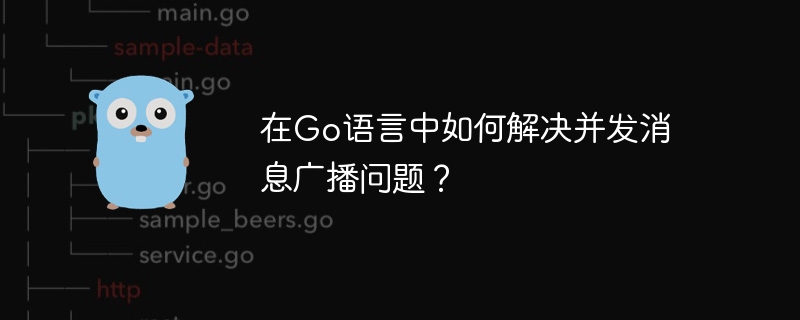

How to solve the problem of concurrent message broadcasting in Go language?
With the development of the Internet, more and more applications need to implement the message broadcast function, that is, sending a message to multiple recipients. In a concurrent environment, it is necessary to ensure that messages can be received by all receivers at the same time without race conditions or missed connections. In Go language, concurrent message broadcasting can be easily implemented by using channels and coroutines.
First, we need to define a message structure to transmit the message content:
type Message struct {
Content string
}Then, create a message channel to receive the sent message:
var messageChannel = make(chan Message)
Next, we create a function that receives the message and sends it to all recipients. This function reads messages from the message channel and sends them to each receiver:
func broadcastMessage() {
for {
// 从消息通道中读取消息
msg := <-messageChannel
// 遍历所有接收者
for _, receiver := range receivers {
// 将消息发送给接收者
receiver <- msg
}
}
}In the above code, we use an infinite loop to continuously receive messages, and use the range function to traverse all receiver. Then, send the message to each recipient's channel. This approach ensures that messages can be sent to all recipients at the same time and there will be no race conditions.
Next, we create a function to receive messages and process them:
func processMessage(receiver chan Message) {
for {
// 从接收者通道中读取消息
msg := <-receiver
// 处理消息
fmt.Println("Received message:", msg.Content)
}
}In the above code, we use an infinite loop to continuously receive messages and process the received messages. The processing method here can be modified according to actual needs, such as printing message content, storing messages in the database, etc.
Finally, we create the receiver channel and start the coroutine for message broadcast and message processing:
var receivers = make([]chan Message, 0)
func main() {
// 创建10个接收者通道
for i := 0; i < 10; i++ {
receiver := make(chan Message)
receivers = append(receivers, receiver)
// 启动消息处理协程
go processMessage(receiver)
}
// 启动消息广播协程
go broadcastMessage()
// 发送消息
messageChannel <- Message{Content: "Hello World!"}
// 程序继续运行
select {}
}In the above code, we create 10 receiver channels and add them Added to slice receivers. Then, a loop is used to start 10 message processing coroutines. Next, start the message broadcast coroutine and send a message through the message channel.
Through the above code examples, we have solved the problem of concurrent message broadcasting in Go language. By using channels and coroutines, we can easily implement concurrent sending and receiving of messages, ensuring that messages can be received by all receivers at the same time without race conditions or missed connections.
The above is the detailed content of How to solve the problem of concurrent message broadcasting in Go language?. For more information, please follow other related articles on the PHP Chinese website!
 The difference between PD fast charging and general fast charging
The difference between PD fast charging and general fast charging
 How to share printer in win10
How to share printer in win10
 WAN access settings
WAN access settings
 java export excel
java export excel
 Virtual mobile phone number to receive verification code
Virtual mobile phone number to receive verification code
 The difference between lightweight application servers and cloud servers
The difference between lightweight application servers and cloud servers
 Complete collection of HTML tags
Complete collection of HTML tags
 The role of index
The role of index




